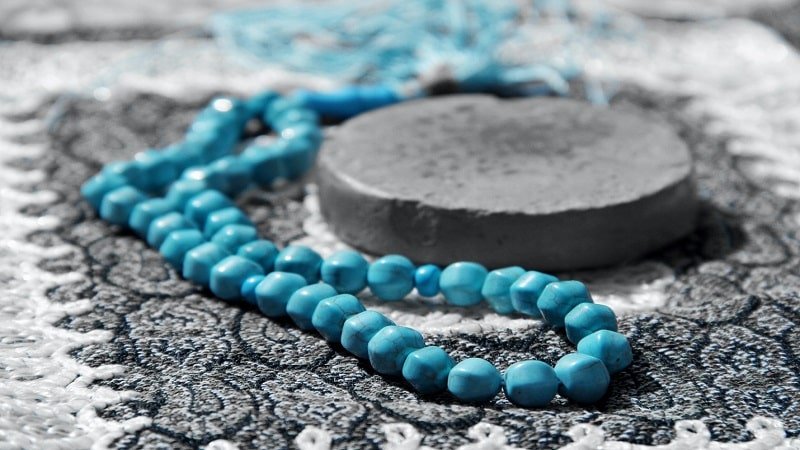How is Turquoise Formed?

You might be aware of a teal-colored gemstone named famous for having imitations for centuries and its use in eastern jewelry. But what is more interesting to know is how turquoise is formed. The reason is that turquoise is not just a gemstone. It is also a mineral, which means its formation is slightly different from other gemstones. Not to mention, by having such close imitations and master copies, it is interesting to see how a close replica of turquoise is formed.
So let’s get into the fundamental part of this article which is how genuine turquoise is formed.
The Formation of Real Turquoise
Natural turquoise is a mineral made of hydrated phosphate of copper and aluminium. Since this is a geological article formation of a mineral, be forewarned that it will be filled with terms that may be difficult to digest. But we are here to help break it down for you.
Components Making a Real Turquoise
Let’s start with a hydrated phosphate like salt or onion but with water content. So these are the two ingredients which are water and phosphorous. For those who aren’t aware of phosphorous, it is a chemical element that is poisonous and explosive. As a non-metal, it exists in the form of white phosphorous.
Copper is another ingredient making up genuine turquoise, a highly malleable metal and ductile with a very high electrical and thermal conductivity. The presence of a copper compound and its interaction with ammonia ligands give the gemstone its teal color.
Aluminium is the last major component with a lower density than other common metals, about one-third of steel. It has an affinity towards oxygen, and hence, it can create a layer of oxide on the surface when air exposure is given. If seen alone, it will resemble silver in terms of color and light reflectivity.
The Main Way a Real Turquoise is Created Naturally
A turquoise will begin to be formed when hydrothermal deposits of copper sulfides begin. The hydrothermal deposits are a collection of valuable minerals created through the hot waters flowing through the Earth’s crust. So, in other words, when rainwater or snow infiltrates the Earth’s surface and starts filtering through the copper porphyry. The oxygen in the water starts dissolving copper sulfides into soluble sulfates. These minerals eventually formed into metallic fluids that started concentrating in certain rock formations, which is a pre-requisition to turquoise’s formation.
So the minerals that are deposited are copper sulfides which you can consider in straightforward terms as compounds of copper. So the metallic fluids that start concentrating on certain rocks will suck copper out of its host rock. This host rock can be a calc-alkaline rock mainly formed when magma cools down below the Earth’s surface. This calc-alkaline rock will have a moderate amount of silicon dioxide that has been oxidized (Hint: this is a result of aluminium’s presence).
The copper is then transferred in a more extreme version known as copper porphyry. This is where copper sulfides will start filling into the joints and gaps of the rock. This process is known as ‘deposition,’ and it takes place in a potassic alteration zone. The unique thing about this zone is that it features the transformation of aluminium mineral rock to potassium feldspar. It also deposits quartz (a mineral) and mica at about 400 to 600 degrees Celsius. The dissolved copper sulfides interact with aluminium and potassium to create turquoise.
Creation of Close Imitations of Turquoise
The ancient Egyptians formed the first replica of turquoise in a container known a ‘faience,’ a sintered-quartz ceramic material. It comprised a sintering process where the material (usually drusy quartz that resembles a turquoise) was used as the base for the copy of a natural turquoise underwent the process of vitrification which is glass-liquid transition. This created a color range that resembled very closely that of an authentic turquoise such as blue or isotropic green.
The later replicas of turquoise were formed using materials like glass, enamel, porcelain, and plastic. It also can be made from other sintered products that are a mixture of copper and aluminium compounds, thus, closely resembling the mineral structure of authentic turquoise.
An example of this is a ‘Viennese turquoise,’ which may look like an authentic turquoise, and it is technically but is not formed naturally. You see, ‘Viennese turquoise is formed using hydrated aluminium phosphate, which is half of the structure in natural turquoise. The only difference is that it is colored by copper oleate, which consists of copper phosphate. So, there is no interaction of aluminium with copper naturally.
However, suppose you visit any market today or order online. In that case, the most mainstream replica of an authentic turquoise is formed by dying howlite or magnesite into a teal color. The reason is that both these minerals are naturally white, with the howlite having a similar black vein formation that makes it resemble a turquoise closely. You might have also seen marble, jasper, and chalcedony, but the reason they have disappeared from the market is that they are not convincing at all. Even if a person knows that they are purchasing a replica of the original gemstone, they still want to have that illusion of reality when looking at the teal-colored stones.
Our Final Thoughts
By now, you would have become a pro about turquoises and how their formation. This is perhaps the only gemstone whose imitation itself is an art in itself with how it is formed. It is, after all, a mineral that has been formed with the involvement of magma and meteoric water, which is hard to replicate even if copper and aluminium compounds are used.
Hopefully, this will help you identify a natural turquoise and prevent you from getting duped by anyone who tries to sell you an imitation for the price of the natural turquoise.